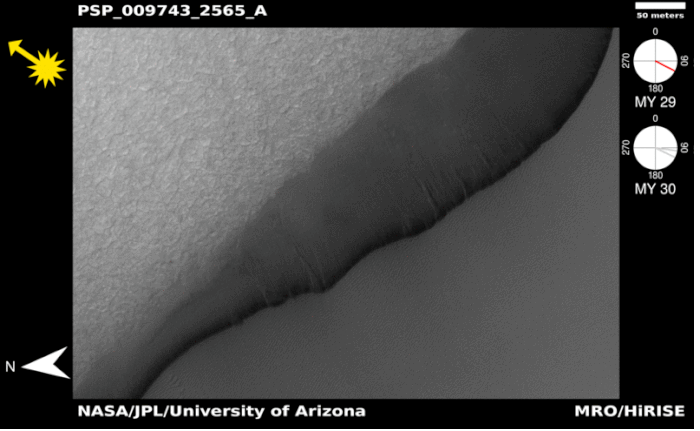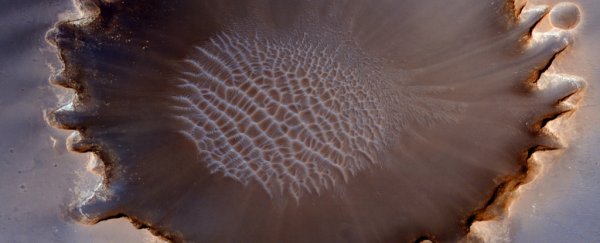Mars and Earth may have a lot of things in common, but the processes that sculpt their sand dunes are not among them. Exactly how Martian sand moves around crevasses and impact craters has been something of a mystery - but we might finally have a better idea.
Planetary scientists have comprehensively revealed how the wild winds, thin atmosphere, temperature, and topography work together to shape the alien landscape - and how it differs from sand movement on Earth.
This research could help in our plans for humanity's eventual trip to Mars.
In spite of the occasional planet-wide dust storm (RIP Opportunity), Martian winds in general don't tend to shift as much sand as you might expect. That's because the planet's atmosphere is thin and weak; in fact, the average surface atmospheric pressure is just 0.6 percent of Earth's sea-level atmospheric pressure.
In turn, this makes the Red Planet's winds rather weak, too.
"On Mars, there simply is not enough wind energy to move a substantial amount of material around on the surface," said planetary scientist Matthew Chojnacki of the University of Arizona Lunar and Planetary Lab.
"It might take two years on Mars to see the same movement you'd typically see in a season on Earth."
Planetary scientists were unsure if Martian sandscapes were still actively moving. Large-scale features are the best places to look for changes, so the team picked out some sand to study.
They chose 54 dune fields, encompassing 495 individual dunes ranging between around 2 and 120 metres tall (6 to 400 feet), and studied images of them taken by the HiRISE camera on the Mars Reconnaissance Orbiter over periods between two and five Mars years, to map sand volumes and dune migration rates.
"We wanted to know: Is the movement of sand uniform across the planet, or is it enhanced in some regions over others?" Chojnacki said. "We measured the rate and volume at which dunes are moving on Mars."
 The migration of a northern dune in one Mars year. (NASA/JPL/University of Arizona)
The migration of a northern dune in one Mars year. (NASA/JPL/University of Arizona)
They found the migration speed for crescent-shaped dunes was an average of just half a metre per year - around 50 times slower than some of the faster sand dunes on Earth.
As the researchers surveyed sand in a variety of locations, including craters, crevasses, canyons, craters, plains and polar basins, they found that, of all the sand regions, the movement was strongest in three locations.
These were the Syrtis Major Planum, a large dark spot between the northern lowlands and the southern highlands, west of the Isidis impact basin; Hellespontus Montes, a mountain range that stretches 711 kilometres between the Noachis Terra and the Hellas Planitia impact basin; and the circumpolar ergs of the Olympia and Abalos Undae, seas of sand circling the north pole.
These three locations are all quite different from each other, except for two key things: they have stark transitions in topography and surface temperature.
"Those are not factors you would find in terrestrial geology," Chojnacki said. "On Earth, the factors at work are different from Mars. For example, ground water near the surface or plants growing in the area retard dune sand movement."
There was one other area with a higher rate of sand movement - although not as high as the first three. These were basins filled with bright dust, which strongly reflect sunlight and heat up the air, creating localised convection currents that move the sand.
Sounds gritty.
The research has been published in Geology.
